Sending a package is like sending an email with attachments. The Package Actions section may appear on the Home page and/or the Packages page:
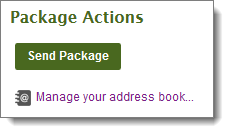
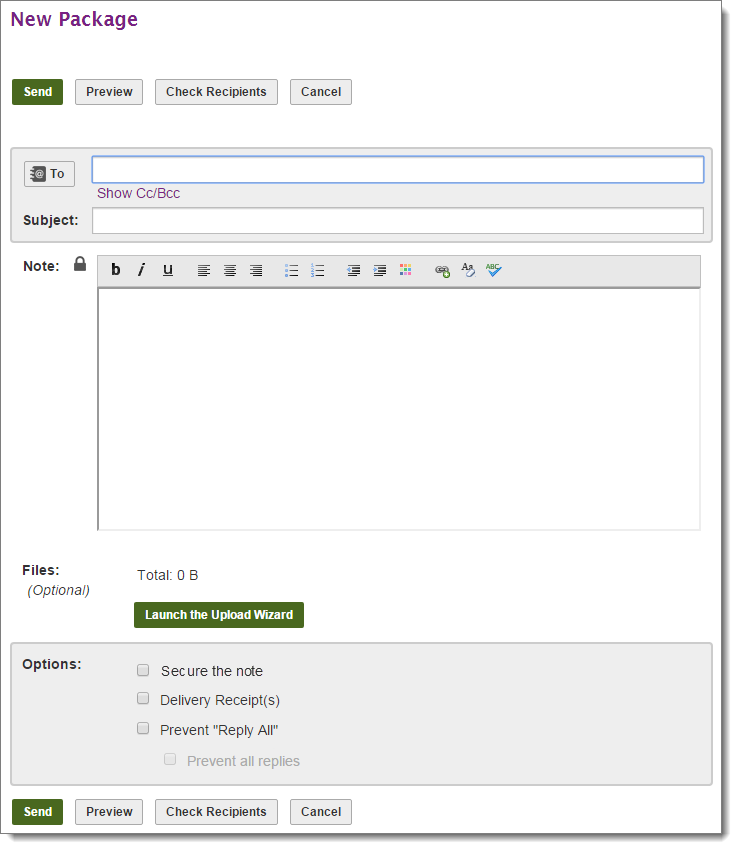
Note: Your signature displays in the note by default, even if you select a different user as sender of the package (if shared mailboxes is enabled).
Rich Text Editor: You may see a rich text editor where you can type your note. In this editor, buttons above the editing box let you change the font, size, style, alignment, indentation, and even color of the text you enter. You can also enter links and lists. Two editors are available depending on the user's browser and that browser's configuration. Users of Internet Explorer, Firefox or Mozilla browsers with JavaScript enabled, will be able to use a rich text HTML editor. This editor lets you add color, change fonts, and add bold, underlined, and/or italicized text to your note and see what it will look like immediately. A Clear Formatting link is also provided to remove all HTML formatting, to facilitate copying in content from various different sources, and making it all look the same. Users who are not able to use the rich text editor will be provided a standard text box in which they may edit their package. This text box allows the entry of standard HTML tags for use of color, bold, underlines, and italics, but the text will all appear plain.
Check Spelling: You may also have a Check Spelling button available, which will check the spelling of both the package subject and the note. Misspelled words will be highlighted and you may use your left mouse button to select appropriate replacements as well as options to ignore that specific word, or all instances of that word. Click Finish to finish the spell-checker.
Note: The spell-checker will not run against notes that contain one or more sequences of characters that are longer than 1,000 characters and are not separated by spaces. If such sequences are detected, an error message will be returned and the spell-check will be aborted.
See Configure the Upload/Download Wizard to learn about the benefits of using the wizard, and how to install and enable it, or disable it if necessary.
The steps you take to upload package files are different depending on what Upload/Download Wizard you're using (if any).

Drag and drop one or more files into the open window from anywhere on your computer, or click Add File to locate and select one or more files. The files do NOT have to be from the same directory. The Wizard can handle files from several different directories (or even drives) at the same time.
Click Upload. The Uploading File window displays the progress of the upload:
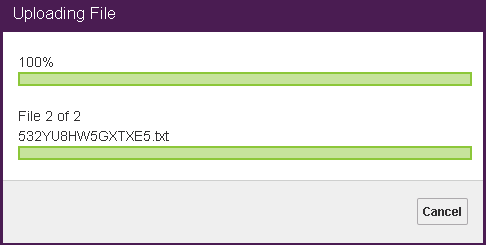
When the files have finished uploading, the MOVEit Upload Wizard shows all files uploaded:
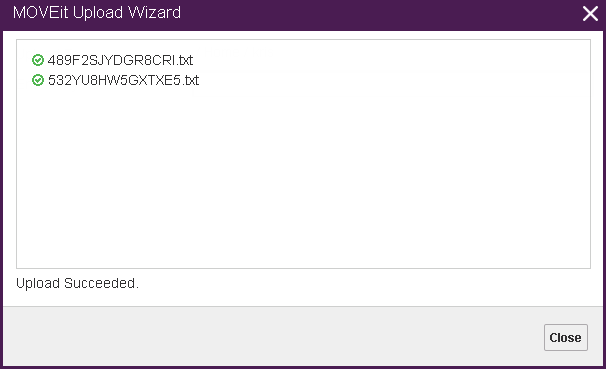
Click Close.
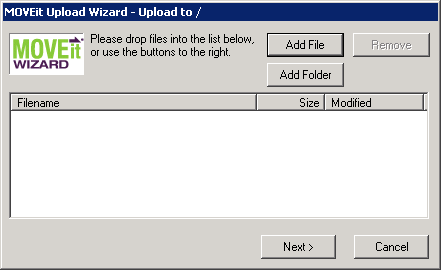
Drag and drop one or more files into the open window from anywhere on your computer, or click Add File to locate and select one or more files. You can also click Add Folder to upload the contents of an entire folder. The files do NOT have to be from the same directory. The Wizard can handle files from several different directories (or even drives) at the same time.
Click Next.
Choose how you want to upload files:
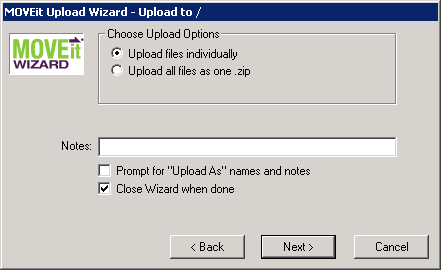
Upload files individually: You'll have the opportunity to Prompt for "Upload As" names to change the name of the file for upload on preceding screens.
Upload all files as one .zip. The .zip file format cannot accommodate zipfiles larger than 4GB, so the Wizard will refuse to create a .zip file if the total size of the data files is greater than about 4 billion bytes. You'll have the option to Prompt for individual zip member names. Although you only have the opportunity to specify the upload notes for the zip file itself, you do have the opportunity to change the names the files stored in the archive will use.
Optionally check Close the Wizard when done. If selected, you'll have to option to Also send package immediately. If selected, when you click Next, the Wizard uploads the file(s) and the package sends automatically.
Press Next > to begin the transfer. As soon as the transfer begins, a progress bar displays how much of your transfer has completed. (The same information will also be displayed in a short text area nearby.)
When complete, you see a transfer summary (unless you selected Close the Wizard when done):
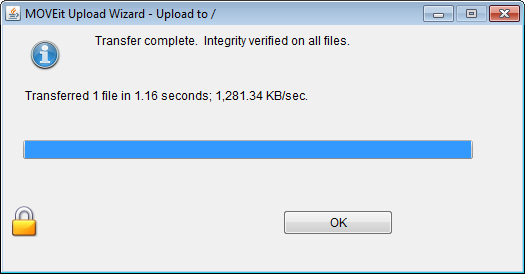
If your administrator enabled content scanning and a virus or data policy violation is detected in a file you selected for upload, the Upload Wizard displays an error and either blocks or quarantines the file. If you selected multiple files for upload, the Upload Wizard uploads all but the infected (or policy violating) file. Filenames and entries in the Notes field are also scanned for data policy violations.
Click OK if necessary to close the Wizard and return to the package.
After you have uploaded a file it appears in the Files list, showing the size of each attached file and the total size for all attached files. Each file shows an integrity check icon that indicates the uploaded file is identical to the original file.

If per package quotas have been set by the administrator, the quota for file size per package will also be shown. If the quota for total packages on the server is set, the lower of this quota and the per package quota is shown.
Note: When a file is added to a package, the file is uploaded to the MOVEit Server. If you click Cancel to stop composing the package, the file is removed from the server. If you click Save as draft or Save as template the file remains on the server.
Note: If an option has been 'locked' by the administrator, the value will be displayed, but you will not be able to change it.
A 'new package notification' email will be sent to your recipients, to inform them that a package is waiting for them. Recipients can click on the web link in this notification to connect to the site and view the package.
Sending to Unregistered Recipients: If you sent the package to an unregistered recipient (recipients that are not MOVEit users), you may be prompted to provide a password, as shown:

In this case, you will need to open the sent package to view the password, which you will need to provide to unregistered recipients by sending it as a separate email, a phone call, fax, etc. in accordance with your organization's security policy.
Recipient Reconciliation
When the Send button is clicked, MOVEit will attempt to reconcile the email address(es) into an existing user, using the following rules: